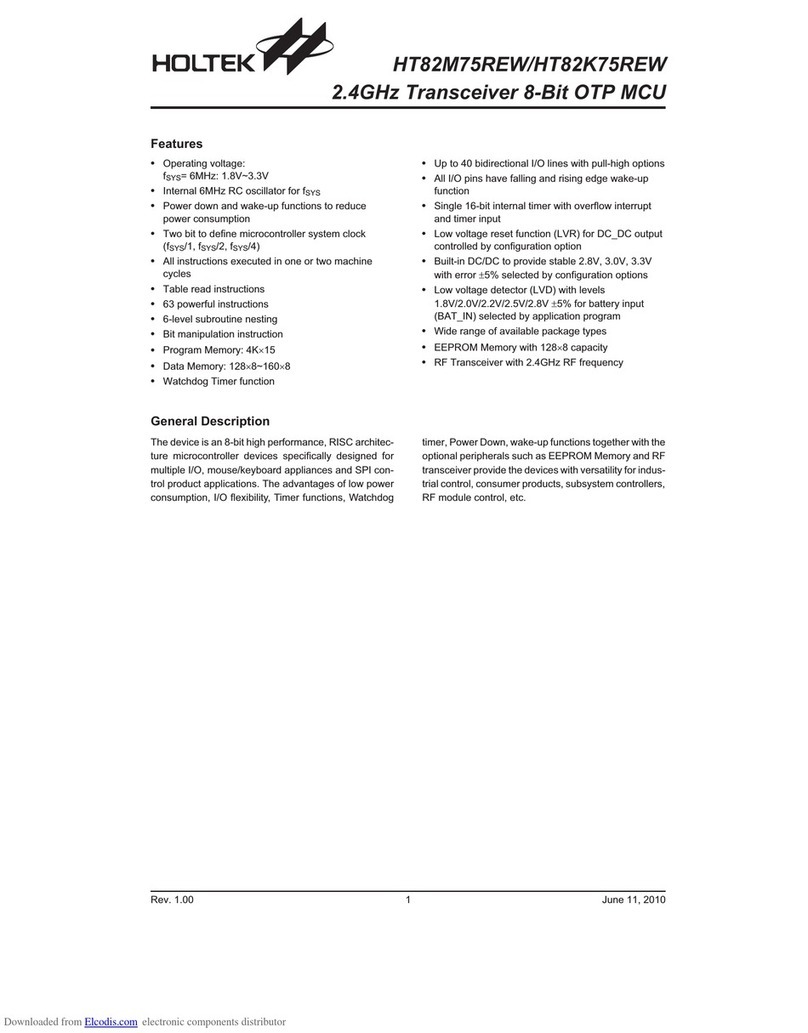
Rev. 1.10 2 October 23, 2020 Rev. 1.10 3 October 23, 2020
BC66F5652
2.4GHz RF Transceiver A/D Flash MCU
BC66F5652
2.4GHz RF Transceiver A/D Flash MCU
Flash Program Memory...................................................................................... 29
Structure......................................................................................................................................29
Special Vectors ...........................................................................................................................29
Look-up Table..............................................................................................................................29
Table Program Example..............................................................................................................30
In Circuit Programming – ICP .....................................................................................................31
On-Chip Debug Support – OCDS ...............................................................................................31
In Application Programming – IAP ..............................................................................................32
Data Memory ....................................................................................................... 46
Structure......................................................................................................................................46
Data Memory Addressing............................................................................................................47
General Purpose Data Memory ..................................................................................................47
Special Purpose Data Memory ...................................................................................................47
Special Function Register Description............................................................. 49
Indirect Addressing Registers – IAR0, IAR1, IAR2 .....................................................................49
Memory Pointers – MP0, MP1L, MP1H, MP2L, MP2H...............................................................49
Accumulator – ACC.....................................................................................................................50
Program Counter Low Register – PCL........................................................................................51
Look-up Table Registers –TBLP, TBHP, TBLH...........................................................................51
Status Register – STATUS ..........................................................................................................51
EEPROM Data Memory....................................................................................... 53
EEPROM Data Memory Structure ..............................................................................................53
EEPROM Registers ....................................................................................................................53
Read Operation from the EEPROM ............................................................................................55
Page Erase Operation to the EEPROM ......................................................................................55
Write Operation to the EEPROM ................................................................................................56
Oscillators ........................................................................................................... 61
Oscillator Overview .....................................................................................................................61
System Clock Congurations......................................................................................................61
External Crystal/Ceramic Oscillator – HXT .................................................................................62
Internal High Speed Internal RC Oscillator – HIRC ....................................................................63
External 32.768kHz Crystal Oscillator – LXT ..............................................................................63
Internal 32kHz Oscillator – LIRC.................................................................................................64
Operating Modes and System Clocks .............................................................. 64
System Clocks ............................................................................................................................64
System Operation Modes............................................................................................................65
Control Registers ........................................................................................................................66
Operating Mode Switching .........................................................................................................69
Standby Current Considerations ................................................................................................72
Wake-up......................................................................................................................................72
Programming Considerations......................................................................................................73
Watchdog Timer.................................................................................................. 73
Watchdog Timer Clock Source....................................................................................................73




























